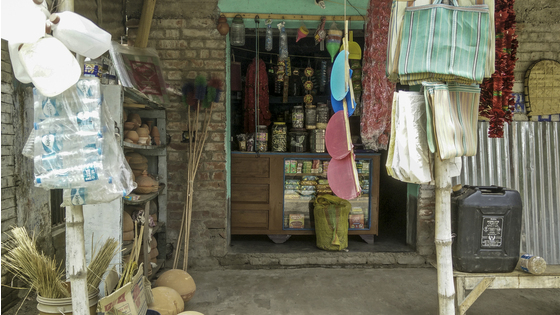In the absence of a solid waste management system, one can find wrappers, pouches, packets, non-biodegradable plastic and styrofoam plates all piled up at the edge of villages. It seems as if this act makes the problem go away (visually at least), much like city-dwellers tend to forget about waste once it has been flushed away or put in the bin. This waste finds its way into natural drains and is then carried by our river systems into the sea.
While walking along the Ganga from the sea to its source I had decided not to buy any packaged products and refused to accept single-use plastics, unless necessary. This was assuming that village stores still stocked locally procured and produced goods. The decision helped me observe patterns in the information that everyday walking was throwing at me.
Everyday discussions at kirana (cornershop) stores about the source and packaging of goods, revealed that plastic was a recent entrant in some places while in most it has been around for some time. Some shop owners could still recall large tin boxes of products that would then be retailed from their stores. Snack and sweet shop owners now completely relied upon styrofoam or plastic coated paper plates. Discussions about going waste-free brought up issues such as "washing dishes is much more expensive than using disposables" and that "no one was even making leaf plates/containers anymore".
The first phase of the walk started in June 2016, three months after the Ministry of Environment, Forests and Climate Change issued the new "Plastic Waste Management and Handling Rules 2016" notification. The second phase of the walk continued in March and April 2017, which also marked the deadline for a few of the clauses in the notification mentioned above. Observations on the ground proved that like many other policies, these guidelines existed only on paper, with most local communities or polluters unaware of their responsibilities.
It seems strange to me that we should run a sanitation campaign in villages along the river, while either completely missing or ignoring the issue of solid waste management, especially non-biodegradable waste. The gap between the existence of a policy and subsequent non-implementation is not a new phenomenon in India, where realities on the ground and that assumed within the political/bureaucratic circles are clearly in different eras. The health of our rivers and the environment has been reduced to a political tool, with no accountability on action or the vision of those (s)elected to dispose of these duties.
Numerous studies released recently attest to the terrible size of the problem:
It is about time we take cognisance of the problem we are facing, and act upon it. Without immediate intervention, this issue is waiting to explode, affecting marine life and agricultural productivity.
Siddharth Agarwal's walk along the Ganga was part of the Moving Upstream series by Veditum India Foundation, aimed at documenting Indian rivers through slow and immersive journeys. You can see more at www.veditum.org.
This photo gallery and accompanying text are republished from The Third Pole
Now more than ever…
Gallery: The plastic trail of the Ganga
Posted by Focus on Arts and Ecology on
- -
Siddharth Agarwal, 18 June 2018
Siddharth Agarwal documents how India has largely ignored the massive proliferation of plastics along rivers like the Ganga
The Ganga flows largely through lightly inhabited rural areas interspersed with industrial units, small towns, and a city every few hundred kilometres. Walking along a river in India can take you to the most magical places where the distance covered in space suddenly begins to feel like a journey in time. Traces of modern development fade away, but then that huge pile of plastic trash brings you back to reality.
chinadialogue is at the heart of the battle for truth on climate change and its challenges at this critical time.
Our readers are valued by us and now, for the first time, we are asking for your support to help maintain the rigorous, honest reporting and analysis on climate change that you value in a 'post-truth' era.
Support chinadialoguePosted in
Ecology












Đăng nhận xét